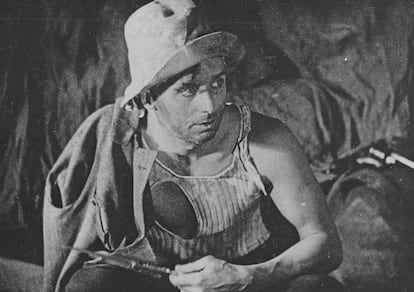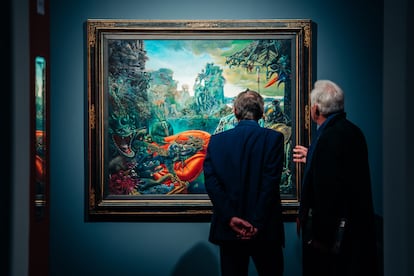Most of his striking and striking work is known from Max Ernst (Brühl, 1891-Paris, 1976), one of the most popular stars of the surrealist movement. A philosopher by training, his creative roots grew far from academic fields and he chose to learn in what at the beginning of the last century were called “madhouses.” His participation as a soldier in the First World War provided him with elements to create the fantastic and terrifying visions of a work that has been widely recognized in the main museums of the world.
What is not so well known is his connection with the world of cinema, a medium in which he participated as an actor, as a screenwriter, as a jury member and even as creator of statuettes for film awards. This year’s celebration of the centenary of the movement led by Breton has become an opportunity to deepen its relationship with the seventh art through the exhibition Max Ernst: surrealism, art and cinema, which can be visited at the Círculo de Bellas Artes in Madrid from this Thursday until May 4. It is an initiative designed to interest all audiences, with around 400 objects that narrate the work and life of the artist. The pieces come from all over Europe, both from public and private collections.
Curated by Martina Mazzota and Jürgen Pech, the exhibition is a co-production of the Círculo de Bellas Artes with Sold Out and Madeinart, cultural entertainment companies with many years of experience. The exhibition premieres in Madrid and, for the moment, it is not known if it will move to another museum setting.

The exhibition is made up of originals and reproductions of the many artistic facets that Ernst touched throughout his life. A born experimenter, he had a great facility for using his hands in new projects. The historian Martina Mazzota affirms that Max Ernst was the Leonardo da Vinci of the 20th century. Everything interested him and he was good at everything. From oil paintings to sculptures, collagesphotographs, illustrated books or rubbinga personal invention that consisted of rubbing on a paper under which a textured object had been placed. The expert said during the presentation this Wednesday that fragments of films and immersive projections have been used that constantly interact with their objects, creating a dynamic and exciting experience. “This exhibition design,” he added, “allows the visitor to delve into the fullness and singular life of Ernst, which covers much of the 20th century and deals with topics such as exile, transculturality and the problems of the Middle Ages, reflecting the progressive vision of the artist.”
Jürgen Pech explains that the exhibition concept that he has worked on with Mazzota has been something as simple as demonstrating Ernst’s connection with cinema. Pech had an easy job because of his job as director of the Max Ernst Museum in Brühl, the artist’s hometown. “We wanted to show the essence of Ernst by surrounding the fundamentals of his work with layers. The speech is long and complex. To facilitate its understanding, we have structured it around film cuts that are true treasures.”

The commissioner refers to the two minutes of screening of The golden age (1930), second surrealist film by Spanish director Luis Buñuel, which is screened almost at the beginning of the exhibition tour. There you can see a young Max Ernst dressed as a bandit and from there some portraits are also taken that highlight the beauty and attractiveness of an artist who would end up pairing with women of the power of Gala Dalí, Leonora Carrington, Peggy Guggenheim or Dorothea Tanning. Other films included in the tour are The dreams that money can buy y 8 × 8: A chess sonata in 8 moves, ambassador Hans Richter; Max Ernst. My wandering, my restlessness, by Peter Schamoni; the short films A week of kindness, by Jean Desvilles, and Maximiliana, by Peter Schamoni, or two pieces by Julien Levy, presented in Madrid to the public for the first time.
The numerous exhibitions that have been dedicated to the centenary of the surrealist movement around the world have complicated loans to make projects like the one in Madrid viable. But Jürgen Pech assures that nothing essential is missing from his narrative. They have been able to put together sets as surprising as the awards he designed to reward cinematographically the filmmakers Henri Gruel, Roman Polanski and Jan Švankmajer. There are also paintings that are difficult to see outside their usual spaces, such as Lot’s daughterson loan from the Pietzsch Collection (Berlin), The Temptations of Saint Anthony (Lehmbruck Museum, Duisburg) or sculptures such as Homme (Museo Max Ernst de Brühl).
Surreal December
The works linked to his stage of maturity are the most humorous, according to the curators. “Aging rediscovered his most playful and joyful time,” comments the curator, while pointing out the relaxed images of one of the videos that close the tour. “As Georges Bataille said, Ernst was a philosopher who played and without play there was no life.”
Valerio Rocco, director of the Círculo de Bellas Artes, took advantage of the presentation of the exhibition to say that December will be a month to celebrate the centenary of the Manifest of surrealism with other events such as the presentation (starting on December 19) of the ballet’s original curtains Bacchanaledesigned and painted by Salvador Dalí. The Ballet Russe de Monte Carlo premiered this work in 1939, at the Metropolitan Opera House in New York. Furthermore, Rocco announced that, “following the example of Climate shelter “last summer, a place has been designed designed for everyone, away from the consumption that surrounds these dates: a huge square in which to enjoy a large number of free activities.”

